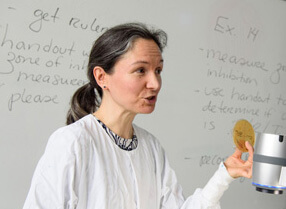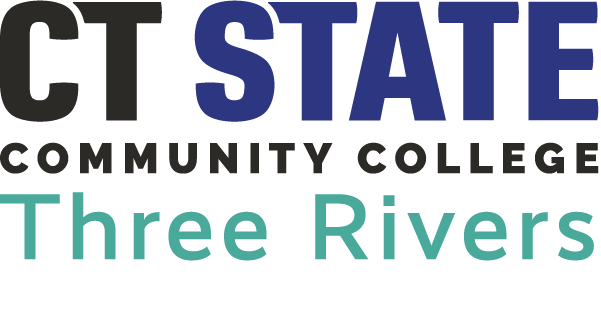In the News | For some local colleges, COVID-19 is now part of the curriculum
New London, CT (The Day, April 11, 2020) — Whether teaching about microbiology or media, some professors at local colleges and universities have shifted their now-online curriculum this semester to include the coronavirus, but Steven Szczepanek was ahead of the curve we’re trying to flatten.

Professor Sarah Selke teaching Microbiology.
After all, he teaches a course called Emerging Infectious Diseases.
The University of Connecticut professor had been reading reports since the beginning of December, and with UConn classes starting in late January, he was ready to “seamlessly integrate the topic into the course” on day one. This is the fifth time he has taught the class, and information about SARS and MERS were already major topics.
For years, he would preach to his class in a lecture at the end of the semester “that it was only a matter of time before another outbreak with one of these viruses was going to cause a devastating global pandemic,” Szczepanek said in an email to The Day. “Welcome to 2020.”
From what he’s heard from students, the class helps them deal with difficult emotions that come with the pandemic. He thinks it gives them peace of mind to study how diseases emerge from an objective point of view.
Szczepanek also teaches a course on vaccines, and he’s one of multiple professors teaching a recently developed interdisciplinary, free, one-credit undergraduate course on COVID-19.
Peter Diplock, assistant vice provost for excellence in teaching and learning, said this past week that the course, The COVID-19 Pandemic: Impacts on Health, Business and Society, has 4,000 students enrolled. He developed the course, which is running April 6 through May 1.
It brings together professors in public health, public policy, pharmacy, finance and more. Diplock said a similar course for faculty, staff and graduate students begins Monday.
“Learn from UConn experts the science behind COVID-19, how to recognize stress and adopt coping mechanisms, and gain insight into the business and financial implications of the pandemic,” the undergraduate course description reads.
At Three Rivers Community College, Sarah Selke considered making the rest of the semester a COVID-19 case study in her microbiology class, but she opted to stick with her normal curriculum and weave the coronavirus in as examples.
“I think there’s a balance that I want to strike,” she said, “because knowledge is power, and I hope that learning more about the biology of COVID-19 actually reassures my students, but at the same time, the pandemic is inescapable.”
One time she used the coronavirus as an example was in talking about how alcohol is used to control microorganisms, and how alcohol can break apart the outer layer on some viruses.
“It’s called an envelope, and if you destroy the envelope, a virus particle cannot infect,” Selke explained. She ordinarily might use a bacterial example, but now, she explained to her students that people are using hand sanitizer because its alcohol content would destroy the envelope of the coronavirus.
Selke also will tie in the coronavirus to the chapter she’s teaching on how viruses replicate, one she said is always very challenging for her students.
“I am thinking that the fact I will be tying it to COVID-19 will make them more invested in the hard work they have to do to understand a difficult concept,” Selke said.
At Connecticut College, the courses don’t even have to be on health or science to tie in the coronavirus: Two English professors are incorporating it in their curriculum.
Jeff Strabone teaches Media Rhetoric and Communication, a course designed to teach students “to recognize the interests that influence journalism and public speech,” he said.
Earlier in the semester, students analyzed parts of President Donald Trump’s State of the Union address and Rep. Adam Schiff’s closing speeches in Trump’s impeachment trial. Strabone had them read primary documents on the impeachment and then read articles from slanted sources, from Jacobin to Breitbart, to see how those organizations interpreted the same documents.
Before spring break, Strabone already had started incorporating examples of coronavirus misinformation.
With the class online since spring break, students have talked about the Defense Production Act and about the dynamic between Trump and Anthony Fauci, director of the National Institute of Allergy and Infectious Diseases.
He gave his students 55 accounts to follow on Twitter — including elected officials, news organizations and advocacy groups — for them to consider which ones they should unfollow for spreading misinformation.
“COVID-19 is an epidemic, but it’s also a media event, so we need to think critically about the media that accompanies the epidemic,” Strabone said, adding, “Misinformation can kill you.”
Julie Rivkin is incorporating COVID-19 into her course on narrative medicine, an interdisciplinary field centered on patients voicing their experiences, thus improving health care services.
Some of the readings have included “Floating Bridge” by Alice Munro, “The Aquarium” by Aleksandar Hemon and “The Interior Castle” by Jean Stafford. After the mid-term, Rivkin decided to change the name of her course to Living in a Pandemic in Real Time.
“Both our public and our personal narratives are undergoing radical and extraordinarily rapid changes day by day and hour by hour,” Rivkin said. So, she’s having students share personal reflections that are guided by previous readings.
One assignment was for students to write about how their sense of time has been altered by the pandemic, and another was to respond to poetry that New York Times readers had written in response to the article “The Doctor and ‘The Apocalypse,'” in which a Boston emergency room doctor wrote a poem about the coronavirus crisis.
“The students have been wonderfully responsive, and I think they make it clear this work is helping them,” Rivkin said. “It’s kind of a space for them to make sense of what they’re going through.”
— By Erica Moser, The Day staff writer
The original article can be found here: “For some local colleges, COVID-19 is now part of the curriculum”
READ MORE
Biology Studies, A.A. – CSCU Pathway Transfer Degree
[mk_page_section bg_image=”https://threerivers.edu/wp-content/uploads/2020/03/398croppedto1450x464.jpg” bg_position=”right top” bg_repeat=”no-repeat” bg_stretch=”true” full_width=”true” padding_top=”0″ padding_bottom=”0″ top_shape_color=”#ffffff” bottom_shape_color=”#ffffff” el_class=”header-section” sidebar=”sidebar-1″][vc_column][vc_empty_space height=”450px”][mk_fancy_title strip_tags=”true” color=”#ffffff” size=”80″ font_weight=”bold” txt_transform=”uppercase” margin_bottom=”0″ font_family=”Oswald” font_type=”google” el_class=”page-title”]Biology Studies, A.A. – CSCU Pathway Transfer Degree[/mk_fancy_title][vc_empty_space height=”100px” el_class=”page-titlebg” css=”.vc_custom_1469643567733{background-color: rgba(77,49,142,0.8) !important;*background-color: rgb(77,49,142) !important;}”][/vc_column][/mk_page_section][vc_row fullwidth=”true” css=”.vc_custom_1469643994949{padding-left: 20px !important;}”][vc_column][ultimate_spacer height=”10″][ultimate_spacer height=”20″][/vc_column][/vc_row]
“I am a Biology Transfer student hoping to go to pre-med at Eastern. As an International student, I pay out-of-state rates, and it’s still less expensive than other universities.
I also like that at Three Rivers, I meet a lot of ethnic groups and that the faculty is always willing to help. The community is like a family because it is such a small school.”
Aaron Nyambe
This program is designed to provide you with a strong foundation in the area of Biology. By studying biology, you will gain insight into the processes and interactions of living things, and the interrelationships of organisms to various colleges within the environment. Upon completion of this Transfer Ticket Biology Studies degree program, you will be able to transfer seamlessly to colleges within the Connecticut College State University system, being guaranteed full junior status in your pursuit of a bachelor’s degree in the same discipline, without losing any credits or being required to take extra credits upon transfer.
Special Opportunities
With this degree, you will be able to transfer, apply to competitive admissions majors, and complete your BA/BS degree in the same time and with the same course requirements as students who start at a CSU or COSC.
Career Options
Biological Technician
Medical or Clinical Laboratory Technician
Easy Transfer Options
These degrees guarantee full junior status, no loss of credits, and no need to take extra credits.
Central Connecticut State University – Biology – General Biology, B.S.; Biology – Ecology, Biodiversity, and Evolutionary Biology, B.S. or Biology – Environmental Science, B.S.
Eastern Connecticut State University – Biology, B.A.
Southern Connecticut State University – Biology, B.A. or Biology, B.S.
Western Connecticut State University – Biology, B.A. or Ecology, B.A.
Charter Oak College (Online) – General Studies – Biology Concentration, B.A.
Related Degrees & Certificates
Because you are interested in the Biology Studies, A.A. – CSCU Pathway Transfer Degree, you might want to look at these programs, too.
Chemistry Studies, A.A. – CSCU Pathway Transfer Degree
Environmental Engineering Technology, A.S.
General Studies, A.S.
Nursing, A.S.
Technology Studies, A.S.
[/vc_column_text][vc_separator][/vc_tab][vc_tab title=”Faculty” tab_id=”1470246169784-2-9″][vc_column_text]
See below for a list of all full-time Department Faculty. Please note that not all listed faculty may teach courses related to this specific degree or certificate program.

Vandana Basu, Ph.D.
B.A., Vassar College; Ph.D., University of ConnecticutMathematics and Science Department Associate Professor of ChemistryFaculty Office Hours (860) 215-9429 VBasu@threerivers.edu

Michael Carta
B.A., M.S., University of DaytonMathematics and Science Department Department Chair and Professor of ChemistryFaculty Office Hours (860) 215-9413 MCarta@threerivers.edu

William Dopirak Jr.
A.S., Mohegan Community College; B.S., Eastern Connecticut State University; M.A. Central Connecticut State UniversityMathematics and Science Department Professor of Natural SciencesFaculty Office Hours (860) 215-9424 WDopirak@threerivers.edu
Erin Mulhern
B.A. & B.S., University of Arizona; M.S., Lehigh University; M.P.H., University of West FloridaMathematics and Science Department Instructor of BiologyFaculty Office Hours (860) 215-9456 emulhern@threerivers.edu

Nicola H Ricker
B.S., University of Connecticut; M.S. University of New HavenMathematics and Science Department Professor of ScienceFaculty Office Hours (860) 215-9474 NRicker@threerivers.edu

Leslie J Samuelson
B.A., University of California at San Diego; M.S., San Diego State UniversityMathematics and Science Department Professor of Biology and Environmental SciencesFaculty Office Hours (860) 215-9467 LSamuelson@threerivers.edu

Sarah B Selke, Ph.D.
B.S., Bates College; Ph.D., University of FloridaMathematics and Science Department Professor of BiologyFaculty Office Hours (860) 215-9470 SSelke@threerivers.edu
Median Salary*[/vc_column_text][vc_column_text css=”.vc_custom_1502920691814{margin-bottom: 20px !important;}”]
CONTACT
*Source: U.S. Bureau of Labor Statistics
[/vc_column_text][/vc_column][/vc_row] READ MORE